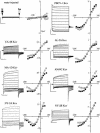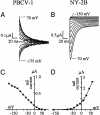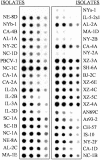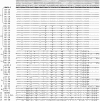Small potassium ion channel proteins encoded by chlorella viruses
- PMID: 14762169
- PMCID: PMC397378
- DOI: 10.1073/pnas.0307824100
Small potassium ion channel proteins encoded by chlorella viruses
Abstract
Kcv, a 94-aa protein encoded by Paramecium bursaria chlorella virus 1, is the smallest known protein to form a functional potassium ion channel and basically corresponds to the "pore module" of potassium channels. Both viral replication and channel activity are inhibited by the ion channel blockers barium and amantadine but not by cesium. Genes encoding Kcv-like proteins were isolated from 40 additional chlorella viruses. Differences in 16 of the 94 amino acids were detected, producing six Kcv-like proteins with amino acid substitutions occurring in most of the functional domains of the protein (N terminus, transmembrane 1, pore helix, selectivity filter, and transmembrane 2). The six proteins form functional potassium selective channels in Xenopus oocytes with different properties including altered current kinetics and inhibition by cesium. The amino acid changes together with the different properties observed in the six Kcv-like channels will be used to guide site-directed mutations, either singularly or in combination, to identify key amino acids that confer specific properties to Kcv.
Figures






Similar articles
-
Chlorella virus ATCV-1 encodes a functional potassium channel of 82 amino acids.Biochem J. 2009 May 13;420(2):295-303. doi: 10.1042/BJ20090095. Biochem J. 2009. PMID: 19267691 Free PMC article.
-
A potassium channel protein encoded by chlorella virus PBCV-1.Science. 2000 Mar 3;287(5458):1641-4. doi: 10.1126/science.287.5458.1641. Science. 2000. PMID: 10698737
-
Genetic diversity in chlorella viruses flanking kcv, a gene that encodes a potassium ion channel protein.Virology. 2004 Aug 15;326(1):150-9. doi: 10.1016/j.virol.2004.05.023. Virology. 2004. PMID: 15262503
-
The viral potassium channel Kcv: structural and functional features.FEBS Lett. 2003 Sep 18;552(1):12-6. doi: 10.1016/s0014-5793(03)00777-4. FEBS Lett. 2003. PMID: 12972145 Review.
-
Are chlorella viruses a rich source of ion channel genes?FEBS Lett. 2003 Sep 18;552(1):2-6. doi: 10.1016/s0014-5793(03)00775-0. FEBS Lett. 2003. PMID: 12972143 Review.
Cited by
-
Phycodnavirus potassium ion channel proteins question the virus molecular piracy hypothesis.PLoS One. 2012;7(6):e38826. doi: 10.1371/journal.pone.0038826. Epub 2012 Jun 7. PLoS One. 2012. PMID: 22685610 Free PMC article.
-
Functions of Viroporins in the Viral Life Cycle and Their Regulation of Host Cell Responses.Front Immunol. 2022 Jun 2;13:890549. doi: 10.3389/fimmu.2022.890549. eCollection 2022. Front Immunol. 2022. PMID: 35720341 Free PMC article. Review.
-
Chlorovirus-mediated membrane depolarization of Chlorella alters secondary active transport of solutes.J Virol. 2008 Dec;82(24):12181-90. doi: 10.1128/JVI.01687-08. Epub 2008 Oct 8. J Virol. 2008. PMID: 18842725 Free PMC article.
-
Pathophysiological Consequences of Calcium-Conducting Viroporins.Annu Rev Virol. 2015 Nov;2(1):473-96. doi: 10.1146/annurev-virology-100114-054846. Annu Rev Virol. 2015. PMID: 26958925 Free PMC article. Review.
-
Identification of Intrahelical Bifurcated H-Bonds as a New Type of Gate in K+ Channels.J Am Chem Soc. 2017 Jun 7;139(22):7494-7503. doi: 10.1021/jacs.7b01158. Epub 2017 May 23. J Am Chem Soc. 2017. PMID: 28499087 Free PMC article.
References
-
- Van Etten, J. L. & Meints, R. H. (1999) Annu. Rev. Microbiol. 53, 447–494. - PubMed
-
- Van Etten, J. L. (2003) Annu. Rev. Genet. 37, 153–195. - PubMed
-
- Plugge, B., Gazzarrini, S., Nelson, M., Cerana, R., Van Etten, J. L., Derst, C., DiFrancesco, D., Moroni, A. & Thiel, G. (2000) Science 287, 1641–1644. - PubMed
-
- Moroni, A., Viscomi, C., Sangiorgio, V., Pagliuca, C., Meckel, T., Horvath, F., Gazzarrini, S., Valbuzzi, P., Van Etten, J. L., DiFrancesco, D. & Thiel, G. (2002) FEBS Lett. 530, 65–69. - PubMed
-
- Gazzarrini, S., Severino, M., Lombardi, M., Morandi, M., DiFrancesco, D., Van Etten, J., Thiel, G. & Moroni, A. (2003) FEBS Lett. 552, 12–16. - PubMed
Publication types
MeSH terms
Substances
Associated data
- Actions
- Actions
- Actions
- Actions
- Actions
- Actions
- Actions
- Actions
- Actions
- Actions
- Actions
- Actions
- Actions
- Actions
Grants and funding
LinkOut - more resources
Full Text Sources
Other Literature Sources

